.
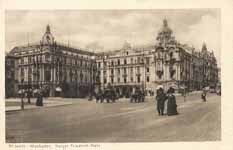
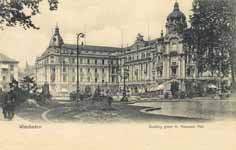
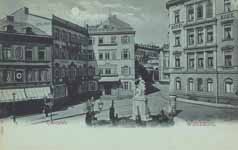
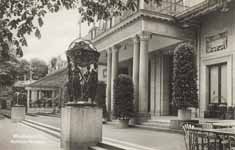

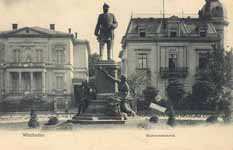

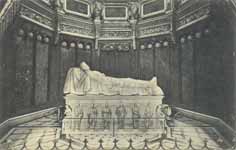
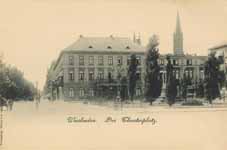
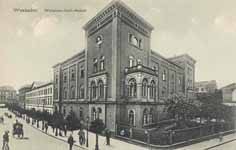
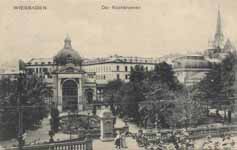
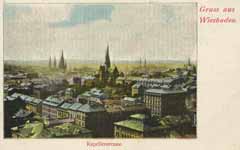
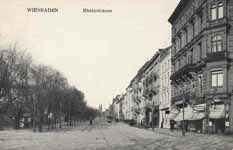
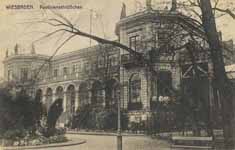
Wiesbaden is a city in southwest Germany and the capital of the federal state of Hesse. It has about 275,400 inhabitants, plus approximately 10,000 United States citizens (mostly associated with the United States Army). Wiesbaden, together with the cities of Frankfurt am Main and Mainz, is part of the Frankfurt Rhine Main Region, a metropolitan area with a combined population of about 5.8 million people.
Wiesbaden is one of the oldest spa towns in Europe. Its name translates to "meadow bath," making reference to the hot springs. At one time, Wiesbaden boasted 27 hot springs. Fifteen of the springs are still flowing today.[2]
19 External links
Geographical Setting
Satellite view of Wiesbaden (north of Rhine river) and Mainz
Wiesbaden is situated on the right (northern) bank of the Rhine River, below the confluence of the Main, where the Rhine's main direction changes from north to west. The city is across the Rhine from Mainz, the capital of the federal state of Rhineland-Palatinate. Frankfurt am Main is located about 38 kilometres (23.6 mi) east. To the north of the city are the Taunus Mountains, which trend in a northeasterly direction.
The city center lies about 5 kilometres (3.1 mi) from the Rhine, in a wide lowland between the Taunus heights in the north, the Bierstadter Höhe and the Hainerberg in the east, the Mosbacher Mountain in the south, and the Schiersteiner Mountain in the west, an offshoot of the Taunus range. The downtown is drained only by the narrow valley of the Salzbach, a tributary of the Rhine, on the eastern flanks of the Mosbacher Mountain. The city's main railway line and the Mainz road (Mainzer Straße) follow this valley. Several other streams drain into the Salzbach within the city center: the Wellritzbach, the Kesselbach, the Schwarzbach, the Dambach, and the Tennelbach, as well as the outflow of many thermal and mineral springs in the Kurhaus (spa) district. Above the city center, the Salzbach is better known as the Rambach.
View of Wiesbaden from the Topographia Hassiae by Matthäus Merianin 1655.
The highest point of the Wiesbaden municipality is located northwest of the city center near the summit of the Hohe Wurzel, with an elevation of 608 metres (1,995 ft) above sea level. The lowest point is the harbour entrance of Schierstein at 83 metres (272 ft) above sea level. The central square (the Schlossplatz, or palace square) is at an elevation of 115 metres (377 ft).
The Wiesbaden municipality covers an area of 204 square kilometers. It is 17.6 kilometres (10.9 mi) from north to south and 19.7 kilometres (12.2 mi) from west to east. In the north are vast forest areas, which cover 27.4% of the urban area. In the west and east are vineyards and agricultural land, which cover 31.1% of the area. Of the municipality's 79 kilometres (49.1 mi)-long border, the Rhine makes up 10.3 kilometres (6.4 mi).
History
The Heidenmauer ("Heathen Wall") is the last remnants of the Roman walls of Aquae Mattiacorum.
Classical antiquity
While evidence of settlement at present-day Wiesbaden dates back to the Neolithic era, historical records document continuous occupancy after the erection of a Roman fort in 6 A.D. which housed an auxiliary cavalry unit. The thermal springs of Wiesbaden are first mentioned in Pliny the Elder's Naturalis Historia. They were famous for their recreation pools for Roman army horses and as the source of a mineral used for red hair dye (which was very fashionable around the turn of BC/AD among women in Rome).[3]
The Roman settlement is first mentioned using the name Aquae Mattiacorum (Latin for "Waters of the Mattiaci") in 121. The Mattiaci were a Germanic tribe, possibly a branch of the neighboring Chatti, who lived in the vicinity at that time. The town also appears as Mattiacum in Ptolemy's Geographia (2.10). The line of Roman frontier fortifications, the Limes Germanicus, was constructed in the Taunus not far north of Wiesbaden.
The capital of the province of Germania Superior, Mogontiacum (present-day Mainz), base of 2 (at times 3) Roman legions, was just over the Rhine and connected by a bridge at the present-day borough of Mainz-Kastel (Roman "castellum"), a strongly fortified bridgehead.
The Alamanni, a coalition of Germanic tribes from beyond the Limes, captured the fort c. 260. Later, in the 370s, when the Romans and Alamanni were allied, the Alamanni gained control of the Wiesbaden area and were in charge of its defense against other Germanic tribes.
[edit] Middle ages
After the Franks under Clovis I defeated the Alamanni in the Battle of Tolbiac in 496, the Franks eventually displaced the Alamanni in the Wiesbaden area over the course of the 6th century. In the 8th century, Wiesbaden became the site of a royal palace of the Frankish kingdom. The first documented use of the name Wiesbaden is by Einhard, the biographer of Charlemagne, whose writings mention "Wisabada" sometime between 828 and 830.
When the Frankish Carolingian Empire broke up in 888, Wiesbaden was in the eastern half, called East Francia (which would evolve into the Holy Roman Empire). The town was part of Franconia, the heartland of East Francia. In the 1170s, the Counts of Nassau, Walram I, received the area around Wiesbaden as a fiefdom. When Franconia fragmented in the early 13th century, Nassau emerged as an independent state as part of the Holy Roman Empire.
In 1232 Wiesbaden became a reichsstadt, an imperial city, of the Holy Roman Empire. However, in 1242, during the war of Emperor Frederick II against the Pope, the Archbishop of Mainz, Siegfried III, ordered the city's destruction.
Wiesbaden returned to the control of the House of Nassau in 1270 under Count Walram II of Nassau-Weilburg. However, Wiesbaden and the castle at Sonnenberg were again destroyed in 1283 in conflict with Eppstein.
Walram's son and successor Adolf would later became King of Germany from 1292 until 1298. In 1329, under Adolf's son Gerlach I of Nassau-Weilburg the House of Nassau and thereby, Wiesbaden, received the right of coinage from Holy Roman Emperor Louis the Bavarian.
In 1355, the County of Nassau-Weilburg was divided among the sons of Gerlach. The County of Nassau's holdings would be subdivided many times among heirs, with the parts being brought together again whenever a line died out. Wiesbaden became the seat of the County of Nassau-Wiesbaden under Count Adolf I (1307–1370), eldest son of Gerlach. It would eventually fell back to Nassau-Weilburg in 1605.
Modern era
Due to its participation in the uprisings of the German Peasants' War of 1525, Wiesbaden lost all its privileges for over forty years. During this time, Wiesbaden became Protestant with the nomination of Wolf Denthener as first Lutheran pastor on January 1, 1543. The same day, the first Latin school was opened, preparing pupils for the gymnasium in Idstein. In 1566 the privileges of the city were restored.
The oldest remaining building of Wiesbaden, the old city hall, was built in 1609 and 1610. No older buildings are preserved due to two fires in 1547 and 1561.
In 1648, at the end of the devastating 30 years war, chronicles tell that Wiesbaden had barely 40 residents left.
In 1659, the Countship of Nassau-Weilburg was divided again. Wiesbaden became part of the Countship of Nassau-Usingen. In 1744, the seat of Nassau-Usingen was moved to Biebrich.
In 1771, the Count of Nassau-Usingen granting a concession for gambling in Wiesbaden. In 1810, the Wiesbaden Casino (German: Spielbank) was opened in the old Kurhaus. Gambling would later be outlawed by Prussian authorities in 1872.
As a result of Napoleon's victory over Austria in the Battle of Austerlitz in 1805, the Holy Roman Empire was dissolved. On July 12, 1806, 16 states in present-day Germany, including the remaining Countships of Nassau-Usingen and Nassau-Weilburg, formally left the Holy Roman Empire and joined together in the Confederation of the Rhine. Napoleon was its "protector." Under pressure from Napoleon, both countships merged to form the Duchy of Nassau on August 30, 1806.
Memorial for Nassauers fallen at the Battle of Waterloo
At the 1815 Congress of Vienna, the Duchy of Nassau joined the German Confederation. The capital of Nassau was moved from Weilburg to Wiesbaden, and the city became the ducal residence. Building activity started in order to give the city a magnificent appearance. Most of the historical center of Wiesbaden dates back to this time.
The Marktkirche's neo-Gothic steeple dominates the center of Wiesbaden.
In the Revolutions of 1848, 30,000 citizens of Nassau assembled in Wiesbaden on March 4. They demanded a constitution from the Duke, which they received.
In the Austro-Prussian War of 1866, Nassau took Austria's side. This decision led to the end of the duchy. After the Austrian defeat Nassau was annexed by Prussia and became part of the Prussian province of Hesse-Nassau. The deposed duke Adolph of Nassau in 1890 became the Grand Duke of Luxembourg (see House of Nassau).
In the subsequent period, Wiesbaden experienced growth as a spa, convention city, and administrative seat. The period around the turn of the 20th century is regarded as the heyday of the city. Kaiser Wilhelm II visited the city regularly in summer, such that it became an unofficial "summer residence". The city was also popular among the Russian nobility. In the wake of the imperial court, numerous nobles, artists and wealthy businessmen increasingly settled in the city. Many wealthy persons choose Wiesbaden as their retirement seat, as it offered leisure and medical treatment alike. In 1894, the present Hessian State Theater, designed by the Vienna architects Fellner and Helmer, was built on behalf of Kaiser Wilhelm II.
Weimar Republic and Third Reich (1919 to 1945)
After World War I, Wiesbaden fell under the Allied occupation of the Rhineland and was occupied by the French army in 1918. In 1921, the Wiesbaden Agreement on German reparations to France was signed in the city. In 1925, Wiesbaden became the headquarters of the British Rhine Army until the withdrawal of occupying forces from the Rhineland in 1930.
In 1929, an airport was constructed in Erbenheim on the site of a horse-racing track. In 1936, Fighter Squadron 53 of the Luftwaffe was stationed here.
In the Kristallnacht pogrom on November 10, 1938, Wiesbaden's large synagogue on Michelsberg was destroyed. The synagogue had been designed by Phillip Hoffmann and built in 1869. Another synagogue in Wiesbaden-Bierstadt was also destroyed. During the Third Reich, a total of approximately 1200 Wiesbaden Jews were deported and murdered.
General Ludwig Beck of Wiesbaden was one of the planners of the July 20, 1944 assassination attempt of Adolf Hitler. Beck was designated by his fellow conspirators to be future Head of State (Regent) after elimination of Hitler. The plot failed, however, and Beck was forced to commit suicide. Today, the city annually awards the Ludwig Beck prize for civil courage in his honor.
Lutheran pastor and theologian Martin Niemöller, founder of the Confessing Church resistance movement against the Nazis, is an Honorary Citizen of Wiesbaden. He presented his last sermon before his arrest in Wiesbaden's Market Church.
World War II
In World War II, Wiesbaden was the Headquarters for Germany’s Wehrkreis XII. This military district included the Eifel, part of Hesse, the Palatinate, and the Saarland. After the Battle of France, this Wehrkreis was extended to include Lorraine, including Nancy, and the Grand Duchy of Luxembourg. The commander was General der Infanterie Walter Schroth.
Wehrkreis XII was made up of three subordinate regions: Bereich Hauptsitze Koblenz, Mannheim and Metz.
Bereich Hauptsitz Koblenz was the headquarters for 12 Unterregion-Hauptsitze, namely Trier I, Trier II, Koblenz, Neuwied, Kreuznach, Wiesbaden, Limburg an der Lahn, Lahn, Mainz, Worms, Darmstadt and Luxembourg.
Bereich Hauptsitz Mannheim was the headquarters for 10 Unterregion-Hauptsitze, namely Saarlautern, Saarbrücken, St. Wendel, Zweibrücken, Kaiserslautern, Neustadt an der Weinstraße, Ludwigshafen (Rhein), Mannheim I, Mannheim II and Heidelberg.
Bereich Hauptsitz Metz was the headquarters for Unterregion-Hauptsitze Metz, Diedenhofen (Thionville) and Saint-Avold.
During the war, Wiesbaden was largely spared by allied bombing raids. But between August 1940 and March 1945, Wiesbaden was attacked by allied bombers on 66 days. In the attacks, about 18% of the city's homes were destroyed and approximately 1,700 people lost their lives.
Wiesbaden was captured by U.S. Army forces on March 28, 1945. The U.S. 317th Infantry Regiment attacked in assault boats across the Rhine from Mainz while the 319th Infantry attacked across the Main River near Hochheim am Main. The attack started at 0100 and by early afternoon the two forces of the 80th U.S.Infantry Division had linked up with the loss of only three dead and three missing. The Americans captured 900 German soldiers and a warehouse full of 4,000 cases of champagne.[4]
Cold War and contemporary history
After World War II, the state of Hesse was established (see Greater Hesse), and Wiesbaden became its capital, though nearby Frankfurt am Main is much larger and contains many Hessian government offices. Wiesbaden however suffered much less than Frankfurt from air bombing. There is a constant rumour that the U.S. Army Air Force spared the town due to its scheduled function as a postwar HQ, but USAAF sources claim this to be a myth, arguing that Wiesbaden's economic and strategic importance simply did not justify more bombing.[citation needed] Wiesbaden was host to the Headquarters, U.S. Air Forces, Europe based at the former Lindsey Air Station from 1953 to 1973.
American armed forces have been present in Wiesbaden since World War II. The U.S. 1st Armored Division was headquartered at the Wiesbaden Army Airfield, just off the Autobahn toward Frankfurt, until the Division completed relocation to Fort Bliss, Texas in 2011. Wiesbaden is now home to the U.S. Army Europe Command and Battle Center. The Smaller supporting American kasernes and housing areas are scattered around the city. More Americans are moving in from bases scheduled to be closed such as Darmstadt and Heidelberg.[citation needed]
Bathing and gambling
Wiesbaden has long been famous for its thermal springs and spa. Use of the thermal springs was first documented by the Romans. The business of spring bathing became important for Wiesbaden near the end of the Middle Ages. By 1370, sixteen bath houses were in operation. By 1800, the city had 2,239 inhabitants and twenty-three bath houses. By 1900, Wiesbaden, with a population of 86,100, hosted 126,000 visitors annually. Famous visitors to the springs included Johann Wolfgang von Goethe, Fyodor Dostoevsky, Richard Wagner, and Johannes Brahms. In those years there were more millionaires living in Wiesbaden than in any other city in Germany.
Gambling followed bathing en suite and in the 19th century Wiesbaden was famous for both. Its casino ("Spielbank") rivalled those of Bad Homburg, Baden-Baden and Monaco. In 1872, the Prussian-dominated Imperial government closed down all German gambling houses. The Wiesbaden casino was reopened in 1949.
Main sights
Panorama of Wiesbaden as seen from the Neroberg
The Palace Square
Former Ducal Palace
The Schlossplatz ("palace square") is situated in the center of the city, surrounded by several outstanding buildings. The ducal palace was begun under William, Duke of Nassau. Its foundations were laid in 1837 and it was completed in November 1841 (two years after William's death). For the twenty-six remaining years of ducal authority it was the residence of the ruling family. It later served as a secondary residence for the King of Prussia 1866 to 1918. It was later used as a headquarters for French and British occupying forces after World War I, then as a museum. Since 1945, the building has served as Landtag (parliamentary building) for the federal state of Hesse. The site of the palace had been that of a castle, probably from the early Middle Ages, around which the city had developed. While nothing is known of the former castle, remains of it were uncovered during excavations after World War II.
The new town hall was built in 1887. Engraved in the paving in front of the town hall are the heraldic eagle of the Holy Roman Empire, the lion of Nassau, and the fleur-de-lis of Wiesbaden. The old town hall, built in 1610, is the oldest preserved building in the city center and now is used as a civil registry office.
The Protestant Marktkirche ("market church") was built from 1852 to 1862 in a neo-Gothic style. Its western steeple is 92 m (302 ft) in height, making the church the highest building in the city.
Kurhaus and Theater
Kurhaus with Fontain of the Bowling Green
Main article: Hessisches Staatstheater Wiesbaden
The monumental Neo-Classical Kurhaus ("spa house") was built at the request of Kaiser Wilhelm II between 1904 and 1907. Its famous Spielbank (casino) is again in operation.
In front of the Kurhaus is a lawn known as the Bowling Green. To one side of the Bowling Green is the Kurhaus Kolonnade. Built in 1827, the 129 meter structure is the longest hall in Europe supported by pillars. To the other side is the Theater Kolonnade, built in 1839. It is adjacent to the Hessian State Theater, built between 1892 and 1894.
St. Bonifatius
Main article: St. Bonifatius, Wiesbaden
St. Bonifatius, the first church for the Catholic community after the Reformation, was built from 1845 until 1849 by Philipp Hoffmann in Gothic Revival style and dedicated to Saint Boniface.
St. Elizabeth's Church
The Russian Orthodox Church of Saint Elizabeth was built on the Neroberg from 1847 to 1855 by Duke Adolf of Nassau on the occasion of the early death of his wife Elizabeth Mikhailovna, who died in childbirth. The architect was Philipp Hoffmann.
Biebrich Palace
Nerobergbahn funicular
St. Elizabeth's Church on the Neroberg
St. Bonifatius
Other sights
Another building from the regency of Duke Wilhelm is the Luisenplatz, a square named for the Duke's first wife. It is surrounded by Neoclassicist buildings, and in the middle of the square is the Waterloo Obelisk, commemorating the Nassauers who died in the wars against Napoleon. Apart from the palace in the center, the ducal family had a large palace on the banks of the Rhine, known as Schloss Biebrich. This baroque building was erected in the first half of the 18th century.
North of the city is the Neroberg. From the top of this hill it is possible to view a panorama of the city. The Nerobergbahn funicular railway connects the city with the hill.
One of the three Hessian state museums, Museum Wiesbaden is located in Wiesbaden.
[edit] Boroughs of Wiesbaden
The city of Wiesbaden is divided into 26 boroughs: five in the central city and 21 suburban districts. The 21 suburban districts were incorporated in four phases from 1926 to 1977. The former right Mainz suburbs Amöneburg, Kastel and Kostheim have belonged to Wiesbaden since 1945.
Boroughs of Wiesbaden
Inner boroughs
Borough Area Population Density Purchasing power
per inh. Map
Mitte[5] 1.53 km² 20,797 13,593 19,707 € Wiesbaden Karte Mitte.PNG
Nordost[6] 19.44 km² 22,621 1,163 21,709 € Wiesbaden Karte Nordost.PNG
Rheingauviertel[7] 2.47 km² 19,802 8,017 17,461 € Wiesbaden Karte Rheingauviertel.PNG
Südost[8] 6.62 km² 18,835 2,845 24,370 € Wiesbaden Karte Südost.PNG
Westend[9] 0.67 km² 16,528 24,669 19,047 € Wiesbaden Karte Westend.PNG
[edit] Suburban boroughs
Borough Area Population Density Purchasing power
per inh. Incorporated since Map
Auringen[10] 3.12 km² 3,399 1,079 22,114 € January 1, 1977 Wiesbaden Karte Auringen.PNG
Biebrich[11] 12.99 km² 36,896 2,840 18,779 € October 28, 1926 Wiesbaden Karte Biebrich.PNG
Bierstadt[12] 9.22 km² 12,109 1,313 22,807 € April 1, 1928 Wiesbaden Karte Bierstadt.PNG
Breckenheim[13] 6.53 km² 3,375 517 22,074 € January 1, 1977 Wiesbaden Karte Breckenheim.PNG
Delkenheim[14] 7.43 km² 4,938 665 20,908 € January 1, 1977 Wiesbaden Karte Delkenheim.PNG
Dotzheim[15] 18.27 km² 26,234 1,436 18,793 € April 1, 1928 Wiesbaden Karte Dotzheim.PNG
Erbenheim[16] 11.27 km² 9,258 821 19,357 € April 1, 1928 Wiesbaden Karte Erbenheim.PNG
Frauenstein[17] 10.65 km² 2,359 222 19,365 € April 1, 1928 Wiesbaden Karte Frauenstein.PNG
Heßloch[18] 1.54 km² 695 451 24,525 € April 1, 1928 Wiesbaden Karte Heßloch.PNG
Igstadt[19] 7.26 km² 2,090 288 21,869 € April 1, 1928 Wiesbaden Karte Igstadt.PNG
Klarenthal[20] 6.13 km² 10,280 1,677 18,103 € September 1, 1964 Wiesbaden Karte Klarenthal.PNG
Kloppenheim[21] 5.39 km² 2,301 427 21,592 € April 1, 1928 Wiesbaden Karte Kloppenheim.PNG
Mainz-Amöneburg[22] 3.71 km² 1,444 389 17,267 € July 25, 1945 Wiesbaden Karte Amöneburg.PNG
Mainz-Kastel[23] 9.51 km² 12,021 1,264 19,874 € July 25, 1945 Wiesbaden Karte Kastel.PNG
Mainz-Kostheim[24] 9.53 km² 13,935 1,462 18,623 € July 25, 1945 Wiesbaden Karte Kostheim.PNG
Medenbach[25] 4.74 km² 2,501 560 21,170 € January 1, 1977 Wiesbaden Karte Medenbach.PNG
Naurod[26] 10.99 km² 4,414 402 21,865 € January 1, 1977 Wiesbaden Karte Naurod.PNG
Nordenstadt[27] 7.73 km² 7,896 1,021 21,503 € January 1, 1977 Wiesbaden Karte Nordenstadt.PNG
Rambach[28] 9.92 km² 2,175 219 24,902 € April 1, 1928 Wiesbaden Karte Rambach.PNG
Schierstein[29] 9.43 km² 10,129 1,074 19,938 € October 28, 1926 Wiesbaden Karte Schierstein.PNG
Sonnenberg[30] 8.34 km² 7,972 956 27,701 € October 28, 1926 Wiesbaden Karte Sonnenberg.PNG
Historical population
Population of Wiesbaden, 1521 to present
Year Population
1521 192 (village)
1629 915
1699 730
1722 1,329
1800 2,239
1840 11,648
1870 33,339
1900 86,086
1910 109,002
June 16, 1925 102,737
June 16, 1933 159,755
May 17, 1939 191,955
September 13, 1950 220,741
June 6, 1961 253,300
May 27, 1970 250,122
June 30, 1975 251,400
June 30, 1980 273,700
June 30, 1985 267,000
May 27, 1987 251,871
June 30, 1997 267,700
January 1, 2002 271,076
September 30, 2005 274,865
Mayors
1849–1868: Heinrich Fischer
1868–1882: Wilhelm Lanz
1882–1883: Christian Schlichter
1883–1913: Carl Bernhard von Ibell
1913–1919: Karl Glässing
1919–1929: Fritz Travers
1930–1933: Georg Krücke
1933–1937: Alfred Schulte
1937–1945: Erich Mix
1945–1946: Georg Krücke
1946–1953: Hans Heinrich Redlhammer
1951–1954: Georg Kluge
1954–1960: Erich Mix
1960–1968: Georg Buch
1968–1980: Rudi Schmitt
1980–1982: Georg-Berndt Oschatz
1982–1985: Hans-Joachim Jentsch
1985–1997: Achim Exner
1997–2007: Hildebrand Diehl
2007– Helmut Müller
This information was retrieved from Die Wiesbadener Oberbürgermeister seit dem Bau des neuen Rathauses (1886) (The Wiesbaden Mayors since the construction of the new town mayor hall (1886) )[31]
Transport
Wiesbaden central station, built between 1904 and 1906.
Wiesbaden's main railway station and several minor railway stops connect the town with Frankfurt, Darmstadt, Mainz, Limburg and Koblenz via Rüdesheim. Wiesbaden Hauptbahnhof is connected to the Cologne-Frankfurt high-speed rail line by a 13-kilometer branch line. Hamburg, München, Leipzig, Dresden, Stuttgart, Mannheim and Hanover are connected directly to Wiesbaden via long distance service of the Deutsche Bahn. More services to locations outside the immediate area connect through Mainz or Frankfurt Airport or Frankfurt Hauptbahnhof. Regional train and bus services are coordinated by the Rhein-Main-Verkehrsverbund.
The city's public transportation service ESWE Verkehr connects all city districts to downtown by 45 bus lines in the daytime and 9 bus lines in the night. Five more bus lines, operated by the public transportation service of the city of Mainz, connects Wiesbaden's districts Kastel and Kostheim to Mainz downtown.
The A66, A671 and A643 autobahns directly service Wiesbaden, connecting to the nearby A3, A60 and A61.
The nearest airport is Frankfurt International Airport and discount airline flights are available at Frankfurt-Hahn Airport around an hour's drive to the southwest.
There are small container port operations nearby on the Rhine and Main rivers.
Military
The US Army Airfield, which is located adjacent to Wiesbaden-Erbenheim, is home of the 66th Military Intelligence Brigade. In addition the United States Army Europe headquarters will move from Heidelberg to Wiesbaden-Erbenheim at the end of 2012. Many building and modernization projects started at the end of 2009. Construction of new housing area at the airfield began in December 2009. The groundbreaking for the new command center was in January 2010.
Events
International May Festival
Main article: Internationale Maifestspiele Wiesbaden
The International May Festival is an annual arts festival presented by the Hessisches Staatstheater Wiesbaden every May. Established in 1896, it is one of the most distinguished international theatre and music festivals in the world. The festival features performances of plays, musicals, operas, and ballets. Concerts from a wide array of music are featured, as are artistic circus acts and modern dance presentations. Lectures, recitals, cabaret performances, and readings are also featured.[32]
Rheingau Wine Festival
The wines and sparkling wines of the close Rheingau are presented annually at the ten-day festival in August, Rheingauer Weinwoche (Rheingau Wine Week) around the Wiesbaden City Hall, on the Schlossplatz (Palace Square), the square Dern’sches Gelände and in the pedestrian area. At 118 booths, Rheingau and Wiesbaden vintners offer their wine and sparkling wine and invite to discover the already well known and favored, but also new vintages. Every year thousands of visitors use this opportunity to get acquainted with Rheingau Riesling wines and all their various facets and flavors. Regional specialities compatible with the wines are offered as well. A diversified musical program entertains the wine festival guests. Initiated more than 30 years ago by the Rheingau vintners, this wine festival has a long tradition.
Twinkling Star Market
Wiesbaden’s Sternschnuppenmarkt is located at the central Schlossplatz and the neighbouring streets of the parliamentary building, old town hall and market church. The Sternschnuppenmarkt takes place from the end of November until December 23 every year and is open from Monday till Thursday 10:30 – 9:00 pm, Friday and Saturday 10:30 – 9:30 pm, and Sunday 12:00 – 9:00 pm.
The market is related to the city arms of Wiesbaden: the colours blue and gold and the three lilies are characteristic. Four gates and an illuminated floral roof symbolizing Fleur-de-lis, consisting of twelve over ten metre high and twelve metre wide luminous lilies, emboss the Sternschnuppenmarkt.
Over 110 booths are decorated in oriental style, coloured blue and gold, offering Christmas style goods, arts and crafts as well as nostalgic carousels and a toy train. An over 28 metre high Christmas tree is decorated with 1000 blue and golden ties, 2500 electric bulbs and 30 flash bulbs. The nativity scene shows life-sized wooden figures.
Rheingau Musik Festival
From the beginning in 1988 the Rheingau Musik Festival has staged summer concerts in the Marktkirche and in the concert hall of the Kurhaus now named Friedrich-von-Thiersch-Saal.
Wiesbaden pedestrian zone 2005.
[edit] Sport
Since 2007 Wiesbaden has been home to SV Wehen Wiesbaden, an association football team that formerly played in nearby Taunusstein.
International relations
See also: List of twin towns and sister cities in Germany
Wiesbaden is twinned with:
Armenia Stepanavan, Armenia
France Fondettes, France
Belgium Ghent, Belgium
Israel Kefar Sava, Israel
Austria Klagenfurt, Austria
Slovenia Ljubljana, Slovenia
Switzerland Montreux, Switzerland
Nicaragua Ocotal, Nicaragua
Spain San Sebastián, Spain
United Kingdom Royal Tunbridge Wells. United Kingdom
Poland Wrocław in Poland (since 1987)[33]
Coat of arms
Wiesbaden's coat of arms features fleurs-de-lys, stylized representations of the city's heraldic symbol, the lily. The blazon is: "Azure, two and one fleurs-de-lys Or".
Notable residents
Notable people born in Wiesbaden include:
Painter Maria Vasilievna Yakunchikova-Weber
American tennis star John McEnroe (who was born on a U.S. military base at Wiesbaden)
F1 driver Nico Rosberg
German film director Volker Schlöndorff
German product designer Dieter Rams, former head of design for Braun
Founder of Anheuser-Busch, Adolphus Busch at the year he was born his birthplace belonged to the city of Mainz not Wiesbaden (born in Mainz-Kastel)
Peter Hanenberger an automotive specialist for General Motors and previous chairman for Australian car giant, Holden
Günther Lütjens, commander of the World War II battleship Bismarck
Henry Schwarzschild, founder of NCADP, LCDC, and head of ACLU's Capital Punishment project in America
Melody Perkins, an actress who played in Power Rangers in Space, and in Power Rangers: Lost Galaxy as the new pink ranger to replace Valerie Vernon
Michael Kessler, the German comedian
Rudolf von Ribbentrop (b.1921) Captain in the Waffen-SS, recipient of the Knights Cross of the Iron Cross for bravery, son of German foreign minister Joachim von Ribbentrop
Kiki Vandeweghe, Two-time NBA All-Star player, later a general manager and coach
Others who have resided in Wiesbaden include:
Richard Wagner settled in Biebrich (now part of Wiesbaden) in 1861, after the political ban against him in Germany was lifted. It was there that he began work on Die Meistersinger von Nürnberg.
Max Reger studied in Wiesbaden.
Priscilla Presley (Beaulieu at the time) lived in Wiesbaden with her parents (her father was an Air Force Officer stationed here). It was here that she met Elvis Presley – she was 14 years old at the time, Elvis was 24.
Reese Witherspoon lived in Wiesbaden with her parents (her father worked for the U.S. military here).
Famous visitors
In the 19th century, visitors to the Wiesbaden's famous hot springs included Johann Wolfgang von Goethe and Johannes Brahms. Brahms' Symphony No. 3 (Op. 90) was composed in Wiesbaden in the summer of 1883.
Russian author Fyodor Dostoyevsky, who suffered from an acute gambling compulsion, allegedly lost his travelling money in Wiesbaden's Spielbank casino in 1865. The experience became the inspiration of his 1866 novel The Gambler (Russian Игрок), set in the fictitious place "Roulettenburg". Some historians have disputed this account, saying that Bad Homburg was the location for Dostoyevsky's real-life misfortune.
Wiesbaden's Bowling Green has been very popular in recent years since various open air concerts have been held there by artists like Elton John (2009 & 2011), Rod Stewart (2009), Eric Clapton (2008), R.E.M. (2003), Sting (2001), Bryan Adams (2000), Simply Red (1999), José Carreras (1992) and Luciano Pavarotti (1993). Lionel Richie and Plácido Domingo (2nd time in Wiesbaden) have also performed there.
[edit] Rivalry with Mainz
Mainz, on the opposite side of the Rhine river, is Wiesbaden's archrival – the two cities are the capitals of their respective Bundesländer, and citizens of both cities jokingly refer to those on the other one as "living on the wrong side of the river".
Fictional references
In the 1983 American television movie The Day After, Wiesbaden was the first city to be destroyed by a nuclear weapon during the escalating war between NATO and Warsaw Pact forces that eventually leads to a full scale nuclear exchange between the United States and the Soviet Union.
References
Notes
^ "Die Bevölkerung der hessischen Gemeinden" (in German). Hessisches Statistisches Landesamt. June 2011.
^ Wiesbadener Tagblatt. September 18, 2008
^ Csysz, Walter: Wiesbaden in der Römerzeit. Aalen: Theiss editors, 2000
^ The Last Offensive by Charles B. MacDonald, Library of Congress Catalog Card Number 71-183070
^ Landeshauptstadt Wiesbaden – Ortsbezirk Mitte, September 2009
^ Landeshauptstadt Wiesbaden – Ortsbezirk Nordost, September 2009
^ Landeshauptstadt Wiesbaden – Ortsbezirk Rheingauviertel, September 2009
^ Landeshauptstadt Wiesbaden – Ortsbezirk Südost, September 2009
^ Landeshauptstadt Wiesbaden – Ortsbezirk Westend, September 2009
^ Landeshauptstadt Wiesbaden – Ortsbezirk Auringen, September 2009
^ Landeshauptstadt Wiesbaden – Ortsbezirk Biebrich, September 2009
^ Landeshauptstadt Wiesbaden – Ortsbezirk Bierstadt, September 2009
^ Landeshauptstadt Wiesbaden – Ortsbezirk Breckenheim, September 2009
^ Landeshauptstadt Wiesbaden – Ortsbezirk Delkenheim, September 2009
^ Landeshauptstadt Wiesbaden – Ortsbezirk Dotzheim, September 2009
^ Landeshauptstadt Wiesbaden – Ortsbezirk Erbenheim, September 2009
^ Landeshauptstadt Wiesbaden – Ortsbezirk Frauenstein, September 2009
^ Landeshauptstadt Wiesbaden – Ortsbezirk Heßloch, September 2009
^ Landeshauptstadt Wiesbaden – Ortsbezirk Igstadt, September 2009
^ Landeshauptstadt Wiesbaden – Ortsbezirk Klarenthal, September 2009
^ Landeshauptstadt Wiesbaden – Ortsbezirk Kloppenheim, September 2009
^ Landeshauptstadt Wiesbaden – Ortsbezirk Mainz-Amöneburg, September 2009
^ Landeshauptstadt Wiesbaden – Ortsbezirk Mainz-Kastel, September 2009
^ Landeshauptstadt Wiesbaden – Ortsbezirk Mainz-Kostheim, September 2009
^ Landeshauptstadt Wiesbaden – Ortsbezirk Medenbach, September 2009
^ Landeshauptstadt Wiesbaden – Ortsbezirk Naurod, September 2009
^ Landeshauptstadt Wiesbaden – Ortsbezirk Nordenstadt, September 2009
^ Landeshauptstadt Wiesbaden – Ortsbezirk Rambach, September 2009
^ Landeshauptstadt Wiesbaden – Ortsbezirk Schierstein, September 2009
^ Landeshauptstadt Wiesbaden – Ortsbezirk Sonnenberg, September 2009
^ Die Wiesbadener Oberbürgermeister seit dem Bau des neuen Rathauses (1886)
^ "International May Festival". staatstheater-wiesbaden.de.
^ "Wrocław Official Website – Partnership Cities of Wrocław". Flag of the United Kingdom.svg Flag of Germany.svg(in English and German) 2007 Wrocław Municipality. Retrieved December 8, 2008.
From Wikipedia, All text is available under the terms of the GNU Free Documentation LicenseWiesbaden

